Pagani Zonda
| Pagani Zonda | |
|---|---|
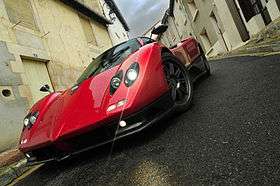 | |
| Overview | |
| Manufacturer | Pagani |
| Production | 1999–2011[1] |
| Assembly | Modena, Italy |
| Designer | Horacio Pagani |
| Body and chassis | |
| Class | Sports car (S) |
| Body style |
2-door berlinetta 2-door roadster |
| Layout | Rear mid-engine, rear-wheel-drive |
| Powertrain | |
| Engine |
6.0 L AMG V12 7.0 L AMG V12 7.3 L AMG V12 |
| Transmission |
5-speed manual 6-speed manual 6-speed sequential |
| Dimensions | |
| Wheelbase | 2,730 mm (107.5 in) |
| Length | 4,395–4,435 mm (173.0–174.6 in) |
| Width | 2,055 mm (80.9 in) |
| Height | 1,151–1,141 mm (45.3–44.9 in) |
| Curb weight |
Dry weight: 1,250–1,210 kg (2,756–2,668 lb) |
| Chronology | |
| Successor | Pagani Huayra |
The Pagani Zonda is a mid-engined sports car built by the Italian manufacturer Pagani. It debuted in 1999, and production ended in 2011, with three special edition cars, the Zonda 760RS, Zonda 760LH and the Zonda 764 Passione, being produced in 2012, and another special edition car, the Zonda 760RSJX, being produced at the end of 2014.[2] By June 2009, 135 Zondas had been built, including development mules. Both 2-door coupé and roadster versions have been produced. Construction is mainly of carbon fiber.
Some of the early Zonda engineering was done by Formula One champion Juan Manuel Fangio. The car was originally to be named the "Fangio F1" after him, but, following his death in 1995, it was renamed for the Zonda wind, a regional term for an air current above Argentina.[3]
Overview
Zonda C12
The Zonda C12 debuted in 1999 at the Geneva Motor Show. It was powered by a 6.0 L (366 cu in) Mercedes-Benz V12 engine producing 394 PS (290 kW; 389 hp) at 5200 rpm and 570 N·m (420 lb·ft) at 3800 rpm mated to a 5-speed manual transmission gearbox. The C12 could accelerate to 60 mph (97 km/h) in 4.2 seconds and to 100 mph (160 km/h) in 9.2 seconds.
Just five of the original 6.0 L Paganis were built, though it was still available in 2002 when the C12 S debuted. One was used for crash testing, while another was a demonstrator and show car. The remainder were delivered to customers during the next three years. A woman from Switzerland is confirmed to own the last remaining Zonda C12, rejecting the offer from Pagani himself to redeem the car for historical reasons.
Zonda S

The Zonda S uses a 7.0 L (427 cu in) AMG–tuned version of the engine producing 550 PS (400 kW; 540 hp). It can accelerate to 62 mph (100 km/h) in 3.7 secs, to 100 mph (160 km/h) in 7.5 secs and complete the quarter mile in 11.3 secs. Lateral acceleration on the skidpad is 1.18 g (11.6 m/s²), it can reach a top speed of 208 mph (335 km/h), and carries a price tag of US$500,000.
The Zonda S features an elongated nose, flaps at the rear for improved aerodynamics, and new light clusters and exhausts. Only fifteen 7.0 L Zonda S cars were produced.
Zonda S 7.3
The Zonda S 7.3 of 2002 used a new, larger V12 engine displacing 7.3 L (445 cu in) designed and manufactured by Mercedes-Benz AMG producing 555 PS (408 kW; 547 hp) and 750 N·m (550 lb·ft). And to better handle the power, traction control and ABS were made standard. Performance claims were unchanged from the Zonda S.
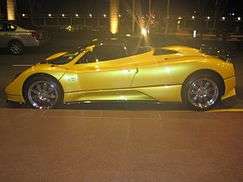
On the Autobahn in which the car topped out at 198 mph (319 km/h), 10 mph (16 km/h) off the mark of its claimed top speed of 208 mph (335 km/h). Company representatives at Pagani's factory claimed this was the result of the car being in the setting for maximum down force, something that would drop its top speed to around 200 mph (320 km/h). However, the EVO article claimed that aerodynamic parts, specifically ones that created drag, were removed during the run, bringing Pagani's claims into question.
Zonda Roadster
In 2003 Pagani presented the Zonda Roadster, a roadster version of the Zonda S 7.3. Carrying the same components as the coupé, Pagani promised no loss of performance, a claim supported by the minimal weight gain of 30 kilograms (66 lb). A total of 40 roadsters were produced.[4]
Zonda F
The Zonda F (or Zonda Fangio - named after Formula One driver Juan Manuel Fangio) debuted at the 2005 Geneva Motor Show. It was the most extensive re-engineering of the Zonda yet, though it shared much with its predecessors including the 7.3 L AMG V12 engine which through enhanced intake manifolds, exhaust and a revised ECU now produced 602 PS (443 kW; 594 hp) at 6150 rpm and 560 lb·ft (759 N·m) at 4000 rpm.
Production of the Zonda F was limited to 25 cars. It came equipped with an extra headlight and different fog lights at the sides, new bodywork (revised front end, new rear spoiler, more aerodynamic vents all around) that improved the car's aerodynamics, and different side mirrors. Further enhancements over the "S" centered on optional carbon/ceramic brakes developed in conjunction with Brembo, alloy wheels, Inconel exhaust system, hydroformed aluminum intake plenum, and a redesigned "Z preg" weave in the crash structure to improve rigidity and reduce weight.
Zonda Roadster F
The Zonda Roadster F debuted at the 2006 Geneva auto show. It was similar to the coupé, but with a removable carbon fibre roof and canvas side curtains, weighing just 5 kilograms (11 lb) more than the coupe. Production of the Roadster F was limited to 25 units.
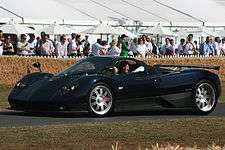
The Roadster F maintained chassis rigidity without any gain in curb weight, eschewing conventional thinking by not strengthening the sills, a process which would have needed more than 35 kilograms (77 lb) of reinforcement. Pagani instead used racing car thinking, materials, and construction techniques, strengthening the firewall structure of the chassis tub together with billet alloy braces that connected the points where the roof rails would have joined. The windscreen was also strengthened for safety reasons. These techniques enabled the Roadster to have virtually the same weight as the coupé, 1,230 kilograms (2,710 lb).[5]

The Zonda Roadster F Clubsport was tested by Top Gear's The Stig and James May and achieved a lap time around their test track of 1:17.8, beating the Bugatti Veyron 16.4 tested during the same episode, but lost in a quarter mile drag race against the Veyron by nearly 2.5 seconds.[6] According to James May, the Zonda F Roadster costs £825,000. German racing driver Marc Basseng managed to lap the Zonda F Clubsport around the 20.8 kilometres (12.9 mi) Nürburgring Nordschleife in 7:24.7.[7]
Zonda Cinque
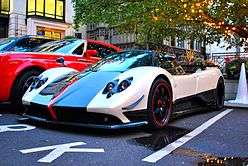
The Zonda Cinque (Italian for five) was meant to be the last iteration of the Zonda, being a road going version of the Zonda R. Only five were built — hence the name — and sold for £1 million ($2,193,070), with deliveries set to June 2009 for all five cars.
The differences from other road-going Zondas were the new 6-speed sequential gearbox, resulting in shifts taking less than 100 milliseconds, dropping 0–62 mph down to 3.4 seconds. The Cinque also had a revised form of carbon fibre called "carbo-titanium" which incorporated titanium to increase strength and rigidity. The suspension used magnesium and titanium components, and the engine's power was increased to 678 PS (499 kW; 669 hp). Revised bodywork, which included a longer front splitter, new sideskirts, rear diffuser, bumper canards, and a flatter underside as well as a roof-mounted air intake scoop, enabled the Cinque to create 750 kg (1,653 lb) of down-force at 355 km/h (221 mph) and 1.45 G of cornering force.
The Zonda Cinque's prototype was designed specially for the purpose of filming a special live-action trailer for Need For Speed: Hot Pursuit, developed by Criterion Games, and built for shooting, with Horacio Pagani himself monitoring the construction of the car.
Zonda Cinque Roadster
The Roadster had the same specs as the Coupé from which it was derived. Only five units were built, with a price of £1.3-million/US$2 million, plus local taxes.[8]

Zonda Tricolore
The final mass-produced Zonda was originally conceived as a one-off; there were actually three Tricolores built. It was built as a tribute to the Frecce Tricolori, Italy's aerobatic team. It carried much of the body from the Zonda Cinque. The car was unpainted except for a clear blue lacquer, and red, white, and green stripes from the nose along the top of the car's surface. Unique to this car was a small wing placed behind the cockpit which reflected the tail wing of Frecce Tricolori's Aermacchi MB-339 PAN stunt plane . The three Tricolores were priced at £1.2 million. It was also 6 mph (9.7 km/h) faster than a standard Zonda at 220 mph (350 km/h).
Special editions
Monza

The Zonda Monza shown at the 2004 Paris Motor Show is a track-day version of the Zonda built for King Moka. Borrowing its appearance cues from the Zonda GR, the Monza included a dry sump version of the Zonda S 7.3 engine tuned to 600 PS (441 kW; 592 hp) and had improved cooling. Modified aerodynamics, including a different wing and front diffuser, allowed greater speed, as did optimized gearing. The car was lighter, with polycarbonate side windows, and an unmuffled exhaust is fitted. The revised interior includes different pedals, steering wheel, and seats, as well as a reinforced roll cage. Larger brakes and a stiffer suspension also improve performance. Finally, an external fire extinguisher is included for safety.
GJ
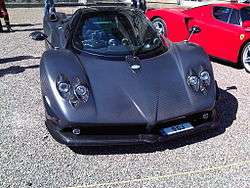
After a crash in Scotland involving "an internationally famous racing champ", a Zonda S owned by Scottish gas industry tycoon Gareth Jones was sent to the Pagani factory and became the one-off custom built Zonda GJ. It was finished in matte carbon and received a front wing upgrade and intake scoops located on the rear wheel arches, as well as several other features taken from the Cinque and F models.
Uno
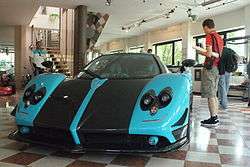
A special one-off built for Sheikh Abdullah bin Nasser Al-Thani, a member of the royal family of Qatar, famous for his turquoise car collection. Originally, the car was a Zonda F Roadster that was crashed in Qatar and was sent back to the factory to be rebuilt.[9] The car specifications are similar to those of a Cinque with the new carbon-titanium chassis. It also has the LEDs on the front of the car like the Tricolore. Unique to this car are the darkened rear lights and the rear exhaust; the four pipes are shorter than standard. Also, the black wheels with turquoise wheel-striping, and the dual-tone diffuser are eye-catchers, together with numerous black accents, like the collector of the exhaust tail pipes. Now the car belongs to a Chinese owner and he also added some unique logos that represented himself.
HH
The Zonda HH is a special one-off edition, in Monterey Blue, that features the engine from the Cinque and most of the bodywork from the Zonda F Roadster. The HH was commissioned by Danish programmer David Heinemeier Hansson.
750
The Zonda 750 was another special one-off edition Zonda for a member of the Al-Thani family. However the order for it was canceled due to a disagreement between the proposed owner and Pagani.[10] The 750 is mainly based on the Cinque, but also features several custom parts. It was expected that it would be finished in a purple colour, but the project was left incomplete in orange with the front end left unpainted. It was later revealed that it was a Zonda Cinque prototype that appeared in the short film of Need For Speed: Hot Pursuit. It was upgraded to 750 bhp upon customer's request. It is now known as the Zonda 760 Nonno. "Nonno" is Italian for grandfather, because it was actually the first prototype for the Zonda F model.
Absolute

The Pagani Zonda Absolute is a special one-off edition Zonda shipped to Hong Kong. It features a matte black carbon fiber body and the engine of the Pagani Zonda Cinque as well as right hand drive.
PS
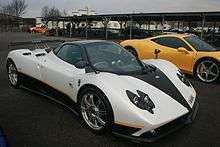
A one-off special that was commissioned by Peter Saywell. It was finished in white with yellow striping on the side.[11] The car is the only one with all four exhaust pipes placed in a row instead of a square.[12] In January 2013 pictures surfaced of a redesigned Zonda PS. The PS has now been finished in bright blue and has the same rear-fin, air intakes, roof scoop and the spoiler as the 760RS & 760LH, but the exhaust pipes arranged in a row have now been replaced with the original layout. Also it features the same day-time LEDs as on the Tricolore, 760LH and the 760RS. What makes this Zonda unique is that its front arches are fitted with carbon-fibre fenders for improved down-force. Actually it's not a formal member of Zonda 760 series because the engine remains the same as before.[13]
Zonda F Roadster Final Edition
The last Zonda F Roadster was commissioned in 2010 and 2011 to commemorate the end of the Zonda F production. All of them were finished with a carbon-fibre body and the power was increased to 665 bhp.
760RS
The Zonda 760RS is another one-off version built for a businessman in Chile, who is said to be a very close friend of Horacio Pagani. It has a 760 hp engine attached to a sequential gearbox and finished with a carbon exterior and black interior. The 760RS also features a distinctive rear fin that runs down the centre of the car, while also feature the same air ducts and roof air intake as the Cinque.[14]
760LH
Same as the Zonda 760 RS, it features a different colour, purple, both for the exterior and the interior, and a manual gearbox instead of the sequential one.[15] It has been commissioned upon request of Formula One driver Lewis Hamilton, hence the initials LH.
764 Passione
The Zonda 764 Passione features the same appearances as that of the 760RS and the 760LH, but it is an upgraded Zonda F and features a bigger rear spoiler and bigger distinctive central rear fin. It is finished in grey carbon fibre with accents of natural carbon fibre with light grey striping on the sides and the Italian flag running alongside the nose just like on the Tricolore. The car has purple-pink interior with wooden steering wheel, all done upon customer's request. The 7.3L V12 AMG M120 engine is tuned to produce 760 hp and is mated to the same 6-speed manual gearbox Lewis Hamilton commissioned on his Zonda. The 764 Passione was delivered to its owner in Tokyo, Japan in December 2012.[16] The car is Zonda F chassis No.83.
760 Fantasma
The 760 Fantasma is the fourth 760-series Zonda, after the 760RS, 760LH and 764 Passione, and is a rebuilt orange Zonda F which was badly damaged in an accident in Hong Kong during 2012.[17] The car was originally commissioned by Peter Saywell, chassis number 53, who later sold it to a Chinese businessman in Hong Kong. After the car's accident it was sent back to the Pagani factory where it was repaired and received all the 760-series upgrades. The central monocoque is the same Zonda F chassis and finished in reddish maroon with the Italian flag running up from its nose like the Zonda Tricolore with the central section left unpainted. The only details remaining unchanged are wheels which are from the Zonda F and the interior.[18]
The 760-series Zondas are considered to be the most powerful road-legal Zondas ever produced.
760 Kiryu
A roadster dubbed the Zonda 760 Kiryu was delivered to Bingo Sports in Japan in 2015, the second 760-series model shipped to that country and the 14th produced overall. The Kiryu features a dark blue tinted carbon fibre body and gloss carbon fibre trim. Excluding the modified Zonda F roadster, the Kiryu is only the second roadster in the 760 series. The Kiryu is reported to have a naturally aspirated 7.3-litre V12 engine producing 760 hp.http://www.carbuzz.com/news/2015/9/23/Ridiculously-Rare-Pagani-Zonda-760-Kiryu-Lands-In-Japan-7729405/
760 LM
This one-of Pagani Zonda was the very last edition of the Zonda made in 2015. The bespoke supercar is based on the 760 RS model and pays tribute to the iconic 24 Hours of Le Mans race. Unlike other special edition Zondas, the LM has revised headlamps (only Zonda which has different headlights) and an even bigger rear spoiler than the original 760RS. The LM also has the tricolore stripes depicting the Italian flag on the right side of the bonnet and the German flag on the other side. The rest of the body is built on standard 760 RS specifications. the engine also went through some modifications as it now produces 800 hp instead of the usual 760 hp. The car has a carbon exterior.
760 OLIVER Evolution
This one-of Pagani Zonda was the very last 760 edition of the Zonda made in 2016. The bespoke supercar is based on the 760 RS model and specially built for one of the big Pagani collector. Unlike other special edition Zondas, this unique 760 has a special design rear spoiler and engineered by one of the world GT champions to generate the maximum downforce to give the ultimate grip on the circuit. The car was tested by the Toyota factory driver and GT500 champion Akira Iida on Fuji Speedway during the Pagani Raduno in Japan this year. Mr Iida commented the Zonda Oliver Evolution is the best handling and closest to the Zonda Eovolution R road car he has ever driven.
Zonda R
| Zonda R | |
|---|---|
 | |
| Overview | |
| Manufacturer | Pagani |
| Production | 2009–2011 (15 produced) |
| Designer | Horacio Pagani |
| Body and chassis | |
| Class | Racing car |
| Body style | 2-door coupé |
| Layout | Rear mid-engine, rear-wheel drive |
| Related | Pagani Huayra |
| Powertrain | |
| Engine | 6.0 L AMG V12 |
| Transmission | Xtrac 672 6-speed sequential manual |
| Dimensions | |
| Wheelbase | 2,785 mm (109.6 in) |
| Length | 4,886 mm (192.4 in) |
| Width | 2,014 mm (79.3 in) |
| Height | 1,141 mm (44.9 in) |
| Curb weight | 1,070 kg (2,359 lb)(dry weight) |
 |
Pagani Zonda R at Goodwood Festival of Speed 2009
|
| Problems playing this file? See media help. | |
.jpg)
The Zonda R debuted at the Geneva Motor Show 2007, using the 6.0 litre V12 M120 engine sourced from the race version of the Mercedes-Benz CLK-GTR.[19] The Zonda R's competition lies with track-based cars, such as the Ferrari FXX and Maserati MC12 Corsa rather than the original Zonda's road competitors as it is not road-homologated.
Despite sharing much of the Zonda's shape, the R is almost entirely new, sharing only 10% of the Zonda F's components. It has been obliquely suggested by Horacio Pagani that this car is a testbed chassis for certain components of the Zonda's replacement, the Pagani Huayra (in the same vein as the Ferrari 288 GTO Evoluzione and the successive F40) and that the Zonda R accurately reflects some of the Huayra's features. Only 15 Zonda R were produced.
Performance
The Pagani Zonda R has a top speed of 218 mph (350.8 km/h), accelerates to 0 to 60 mph (0.0 to 96.6 km/h) in less than 2.7 seconds, can brake from 60 to 0 mph (96.6 to 0.0 km/h) in 96.0 ft (29.3 m), and corners at 1.62g.
Chassis
The central carbon chassis incorporates a roll cage and a rubber racing fuel cell with 4 fuel pumps and quick refuel filler cap, similar to GT race cars. The wheelbase has been increased by 47 mm (1.9 in) to increase stability. The front and rear subframes are brand-new, built to accommodate new suspension geometry, and produced in Avional. The slick-shod wheels are new forged-magnesium center-lock models, which in conjunction with on-board pneumatic airjacks (again, like the FXX) allow rapid change of the entire wheel assemblies.
The car senses, displays and logs information about the amount of down-force that is generated at each wheel at all times. It is thought that this system will enable owners to adjust set-up according to track conditions and to improve their cornering technique.
Bodywork
In addition to the wheelbase increase (47 mm), overall length has increased by 394 mm (15.5 in) and track by 50 mm (2.0 in). The bodywork and aerodynamics have been altered to offer maximum down-force, featuring a longer front bonnet with flaps, a closed underbody and a new rear overhang with adjustable rear wing and race-derived diffuser. These are intended to translate into increased aerodynamic efficiency and down-force for maximum cornering speed. It is also noted that the car's new rear bodywork is minimal in the extreme, being composed mostly of vent. This is thought to be symptomatic of the need to keep the engine cool enough, even under hard track use. Again, this is similar to the gutted bodywork of the Ferrari FXX Evoluzione.
Engine
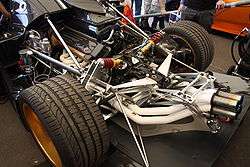
Output has increased to 750 PS (552 kW; 740 hp) at 7500 rpm and 710 N·m (524 lb·ft) of torque. A lightweight carbon fibre high performance intake system, racing multiple disc centered clutch and Formula One-style exhaust system, hydroformed in Inconel 625 and ceramic coated for optimal heat dissipation, have been added. The AMG-built engine is mated to a 6-speed longitudinally-mounted manual sequential synchronized gearbox.
Interior
The car's interior is spartan, reflecting the car's racetrack aspirations and intended home, and features seats customized to the driver to offer maximum support. As before, the Digitek instrumentation provides essential information and the sophisticated telemetry allows a variety of sensors to monitor numerous aspects of the car.
Nürburgring
The Zonda R holds the record for production based cars at the Nürburgring with a lap time of 6:47.48.
Zonda R Evolution
The Zonda R Evolution is an updated version of the Zonda R. It features many changes over the previous Zonda R. Also the car takes many pieces and inspirations from the Zonda 760RS. It is finished in pearl white with exposed carbon-fibre on the nose. The 6.0L V12 engine is uprated to 800 hp. The body work is still the same, but has improved aerodynamics. It features a bigger air spliter above the two standard air spliter on the front bumper and a pair of small splitter on the sides of rear bumper. A bigger rear central fin — even bigger than the 760 series Zondas — and a small spoiler added below the standard Zonda R spoiler improves aerodynamics and increases down-force.
Zonda Revolución

Pagani unveiled the final version of the Zonda, called Zonda Revolución to clients and family members during "Vanishing Point 2013", the International Pagani gathering.[20] The central monocoque is carbon-titanium, the needle on the scale stops at 1070 kg. The Mercedes-AMG engine is an evolution of the Zonda R powerplant. The 6.0-liter V12 now develops an output of 800 hp (597 kW; 811 PS) and 730 N·m (540 lbf·ft) of torque,[21] resulting in a power to weight ratio of 748 hp per tonne. The Xtrac 672 6-speed transversal and sequential gearbox changes gears in 20ms. The traction control developed by Bosch with 12 stage traction control and the renewed ABS system, allows the vehicle to further adapt to the driver's driving style. The aerodynamics feature new and updated canards on the front, as well as a vertical stabilizer supporting the main rear wing. The Zonda Revolución also features a DRS (Drag Reduction System) on the rear wing. The system has two different operating modes, both can be activated by the driver at any time. The manual system is controlled with the DRS button on the steering wheel. The rear wing changes between maximum and minimum down-force settings, at the occurrence of a lateral acceleration of 0.8 g and a minimum speed of 100 km/h (62 mph). Holding down the DRS for more than two seconds engages the DRS to work automatically according to the algorithms developed by the Pagani engineers during the development phase. The main rear wing also utilises mounts on the side of the vehicle alongside a smaller wing at the end of the vertical stabiliser. The Brembo braking system adopts new CCMR discs derived from F1 technology. With a weight saving of 15% compared to the previous CCM discs, the CCMR offer higher stiffness and lower operating temperatures on extreme track use. This contributes to the life of the disc which is increased by four times, with no sign of fading and a significant overall increase in braking power. Each Revolución, of which only five were built, was priced at €2.2 million before taxes.
-

Front 3/4
-

Rear 3/4
Racing
Zonda GR
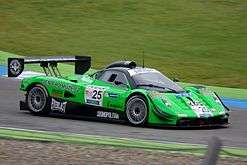
Development of the Zonda GR started in December 2002. At this stage the Zonda was nearly four years old, but had yet to be entered in major motorsports. Tom Weickardt, owner of American Viperacing, Toine Hezemans, owner of Carsport Holland, and Paul Kumpen, owner of GLPK Racing, created a new company, Carsport Zonda, to build a racing version. They secured exclusive rights to develop, build and sell competition Zondas from Horacio Pagani, and the first GR was completed at Carsport's facility in Modena within months.
The Zonda GR is based on the Zonda S. It was built on the same carbon fiber chassis, with tube frames in front and back. The bodywork was modified to include front and rear diffusers and louvers for improved aerodynamics. The car was 2 meters (6.6 ft) wide, in accordance with the regulations of the FIA and ACO. The car's weight was reduced to 1,100 kilograms (2,400 lb), and a new suspension was designed. New wheels and brakes were also specified. The engine was equipped with an enlarged radiator, and the engine and gearbox also had new oil coolers.
The performance of the Zonda GR is well beyond that of the stock car. The car sprints from 0 to 60 mph (97 km/h) in 3.3 seconds and the engine produces around 600 PS (440 kW; 590 hp) at 5,800 rpm and 580 lb·ft (786 N·m) of torque at 4,300 rpm with a redline increased to 7,500 rpm.
The car was entered into the 2003 24 Hours of Le Mans, but retired after ten laps due to a gearbox failure.[22]
Gallery
-
2.jpg)
Pagani Zonda F engine
-
Pagani Zonda
-

Pagani Zonda Roadster
-

Pagani Zonda PS (Peter Saywell)
-

Interior of Zonda Absolute
-

Pagani Zonda F Carbon Edition
Notes
- ↑ © duPont REGISTRY™ (2007-03-08). "2013 Pagani Zonda R Evo Review, Specs, and Pictures". © duPont REGISTRY™. Retrieved 2012-08-10.
- ↑ "2014 Pagani Zonda 760 RSJX".
- ↑ m120
- ↑ Zonda Roadster Pagani Automobili 2013-07-14
- ↑ "Further information and photos". Sybarites.org. 2006-02-24. Retrieved 2010-10-05.
- ↑ "Pagani Zonda vs Bugatti Veyron". topgear.com. 2014-08-09. Retrieved 8 September 2014.
- ↑ "PistonHeads Headlines". Pistonheads.com. 2009-08-20. Retrieved 2010-10-05.
- ↑ "Pagani Zonda Cinque Roadster news - Cinque hole - 2009 - BBC Top Gear". Topgear.com. Retrieved 2009-09-19.
- ↑ "Pagani Zonda 750 One-off - Page 2". Teamspeed.com. Retrieved 2011-03-20.
- ↑ "Pagani Zonda 750 One-off". Teamspeed.com. Retrieved 2011-03-20.
- ↑ "Pagani Zonda PS". Flickr. Retrieved 26 January 2013.
- ↑ "Zonda PS exhausts". Flickr. Retrieved 26 January 2013.
- ↑ Anderson, Brad (11 January 2013). "Redesigned Pagani Zonda PS Spied for the First Time". GTspirit. Retrieved 26 January 2013.
- ↑ "Extreme Pagani Zonda 760 RS Caught on Camera". GTspirit. Retrieved 2012-04-05.
- ↑ Tutu, Andrei (21 May 2012). "Lewis Hamilton Gets a Pagani Zonda". Autoevolution. Retrieved 11 September 2012.
- ↑ "Gallery: Pagani Zonda 764 Passione". GTspirit.com. Retrieved 2012-12-02.
- ↑ "Car Crash: Pagani Zonda F Wrecked in Hong Kong - Update". gtspirit.com.
- ↑ Brad Anderson (14 February 2014). "One-off Pagani Zonda 760 Fantasma Revealed in Hong Kong". GTspirit. Retrieved 21 February 2014.
- ↑ Tom Stewart (2007-03-08). "Hasil Penelusuran Gambar Google untuk http://farm4.static.flickr.com/3660/3614615477_3e4f72c0af.jpg". Revue Automobile. Retrieved 2008-03-12. External link in
|title=(help) - ↑ "Pagani Zonda Revolucion at the 9° Pagani Gathering". Pagani Automobili. Retrieved 2013-06-05.
- ↑ "Pagani Says Goodbye to the Zonda with the Revolucion". Automoblog.net. 2013-06-04. Retrieved 2013-06-05.
- ↑ "Auto News - GT Cars - Pagani challenges Ferrari ! - The official website of 24 Heures du Mans". 24h-lemans.com.
http://m.caranddriver.com/pagani/huayra
External links
| Wikimedia Commons has media related to Pagani Zonda. |